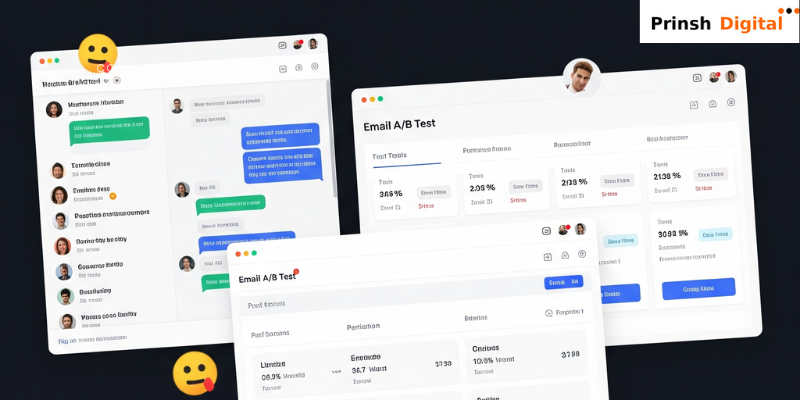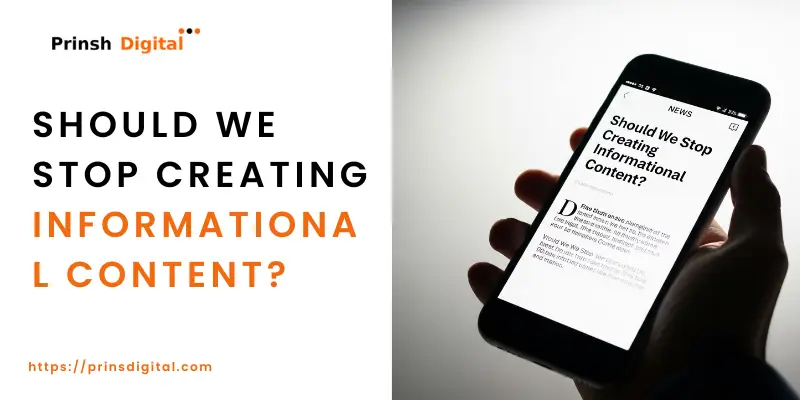The short answer: No, we should not stop creating informational content but we must evolve how and why we create it.
Rise and Overload of Informational Content
When you open your feed you see 10+ versions of the same blog post like:“How to do X in 2025.”“10 Tips for Y.”“Complete Guide to Z.”Sound familiar?For many years, informational content has been the backbone of content marketing. But now, with content saturation, algorithm updates, and audience fatigue, it’s time we ask the uncomfortable question:Should we stop creating informational content?This blog explores the current state of content marketing, Google’s evolving priorities, what audiences actually want, and how brands can reinvent their strategy by going behind-the-scenes, adding insights, and creating true value.

1. The Rise of Informational Content
In the early 2010s, blog posts like “How to Start a Blog” or “5 Tools for Email Marketing” were golden. They solved real user problems and generated traffic. But today?
We’re in Content Overload Mode
According to Master Blogging Over 7.5 million blog posts are published every day
Informational content is everywhere, all of it says the same thing. Why?
- SEO pressure leads to keyword-stuffed articles.
- AI tools make it easy to mass-produce content.
- Brands follow trends rather than adding original insight.
This led a race to the bottom, more content, but less value.
Also, read
How to Increase Organic Traffic of your Website
2. Google’s Evolving Search Landscape: Enter E-E-A-T
What is E-E-A-T?
Google’s ranking systems emphasizing EEAT
- Experience – Author Experience in that field?
- Expertise – Is the author knowledgeable in the subject?
- Authoritativeness – Authority of the Website and business?
- Trustworthiness – Is the content accurate and credible?
Google quality raters now assess whether content is AI-generated read full article on Search Engine Land
Informational content that simply rewords what’s already out there won’t cut it anymore.
Our Suggestion:
If your blog post doesn’t include original insight, firsthand experience, or actionable value, it will not perform well.
3. What Audiences Really Want in 2025
With blogs now we are competing with TikTok, YouTube Shorts, newsletters, podcasts, and LinkedIn threads.
So what actually resonates?
Insight Driven, Not Info-Dumped
People crave perspective, not just facts. They want to know:
- What worked for you.
- What failed and why.
- What you’d do differently.
Use Behind-the-Scenes Stories:
Instead of: “How to Build a Funnel”
Try: “Our $40k Funnel Build What Worked, What Flopped, What We’d Do Differently”
Instead of: “How to Rank on Google”
Try: “How We Took a Blog From 0 to 50k Organic Views in 6 Months—And the Mistakes We Made”
This builds trust, relatability, and authority for the exact goals of good content.
4. Should We Stop Creating Informational Content?
Let’s be clear: No, we shouldn’t stop.
But we should stop creating uninspired, copy-paste informational content.
Informational Content Still Has a Place When:
- You’re answering very specific audience questions.
- You’re explaining complex topics in simple ways.
- You have a fresh perspective or data to back it up.
- You tie it to a real-world experience.
What to Stop Doing:
- Creating “Ultimate Guides” that say nothing new.
- Writing for Google without thinking of the reader.
- Recycling competitor content without adding value.
5. How to Make Informational Content Worthwhile Again
Here’s a framework to evolve your content from generic to genius.
1. Layer Insight Into Information
Don’t just say what to do, explain why it matters and how you’ve done it.
Example:
Instead of “5 Ways to Grow on LinkedIn,”
write: “How I Got My First 10K LinkedIn Followers: What Actually Worked”
2. Use Behind-the-Scenes as Content Fuel
Your process is your story.
Show the messy middle, the failed launches, the version 1.0.
People connect with real journeys.
Content Ideas:
- What We Learned After a Failed Campaign
- How We Doubled Conversions by Rewriting Our Copy Behind the Scenes
- Why Our Product Launch Flopped (and What We’re Doing Differently)

3. Add Graphs and Visual Data
Visuals boost credibility and clarity. Use tools like:
- Google Data Studio
- Canva (charts and templates)
- Notion / Figma for process breakdowns
📊 Include:
- Performance charts before vs. after a strategy shift
- Timeline visuals of a content campaign rollout
- Audience engagement trend graphs
4. Blend Formats: Text + Video + Interactive
Informational content doesn’t have to be just a blog post.
✅ Try:
- Loom walkthroughs
- Carousel summaries on LinkedIn
- Short-form video of blog insights
- Embedded polls, quizzes, or calculators
6. The Future of Content Marketing: Authority-First, Depth-Driven
To future-proof your content strategy:
- Build topical authority in niche subjects.
- Focus on firsthand experiences, not secondhand summaries.
- Invest in depth, not just volume.
- Combine education + entertainment (edutainment).
We’re not just competing for keywords. We’re competing for attention, trust, and memory.
Conclusion: Don’t Stop Evolve it
So, should we stop creating informational content?
No. But we must reinvent it.
Your audience doesn’t need another Complete Guide to SEO.
They need your story, your experiments, your frameworks and yes, your failures too.
The next era of content will be real, raw, and radically helpful.
If you lead with insight and honesty, your content will rise above the noise.



